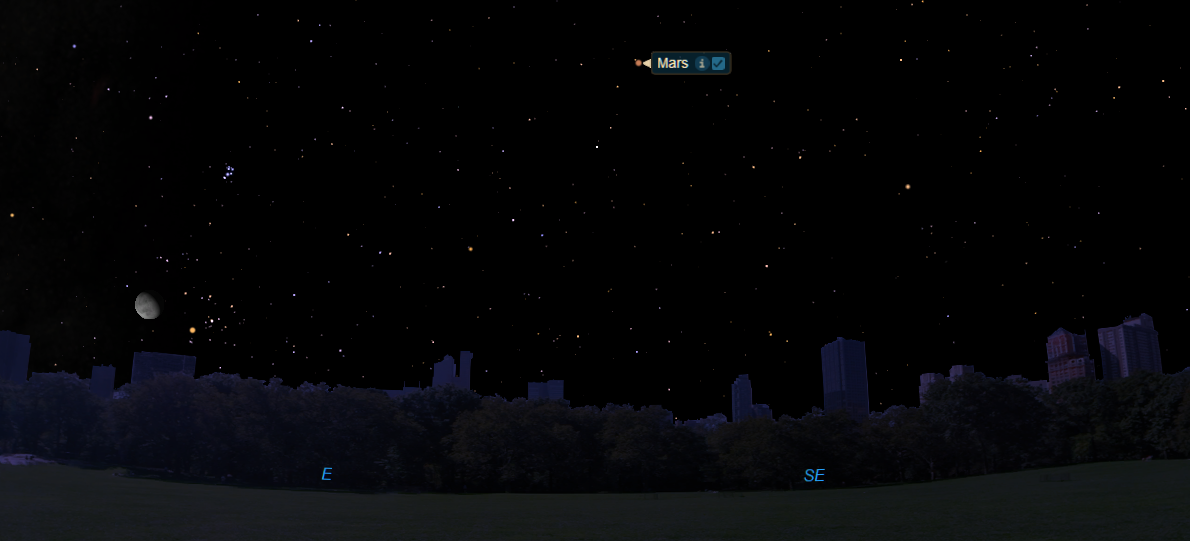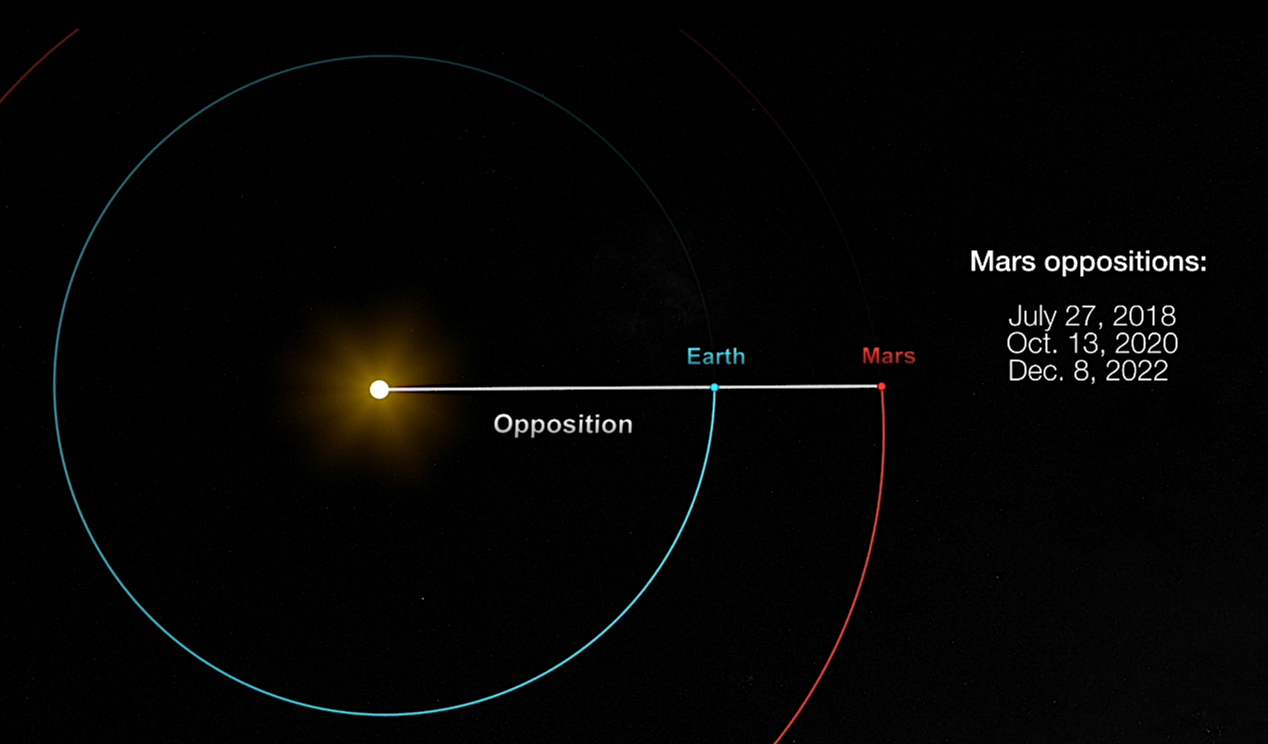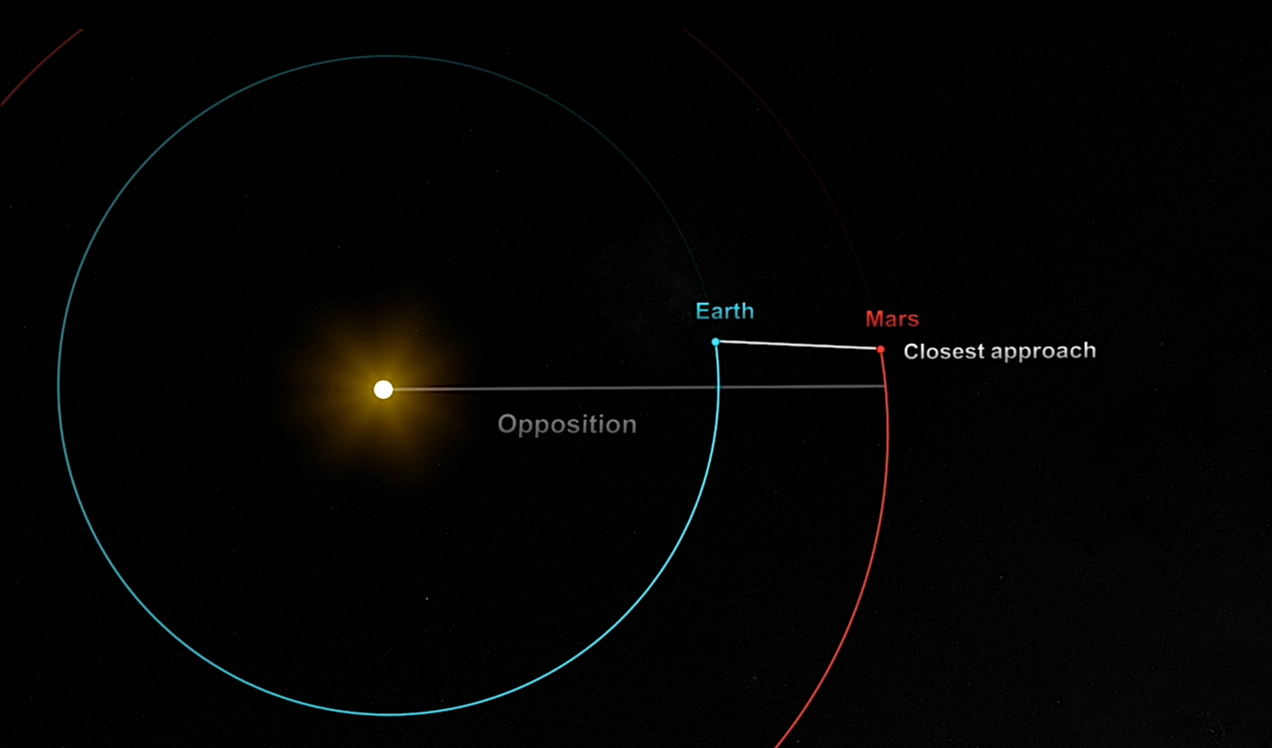Mars is at its closest to Earth until 2035. Here's how to see it.
Look up and marvel at the Red Planet!

Look up! Mars is at its closest to Earth until 2035 today (Oct. 6), making it a perfect time to see the Red Planet with your own eyes.
Today at 10:18 a.m. EDT (1418 GMT), Mars swoops within 38,568,816 miles (62,070,493 kilometers) of Earth, making a smooth close approach. This will be the closest the Red Planet will come to Earth for the next15 years, or until September, 2035, according to Earthsky.org.
The planet is visible high in the eastern sky. It appears as a stunning reddish light, weather permitting.
"October is a great time for viewing Mars, as the planet is visible all night right now, and reaches its highest point in the sky around midnight," NASA wrote in a skywatching guide.
Related: You don't want to miss Mars shining bright this fall
Earth and Mars travel around the sun in elliptical orbits, orbiting in the same direction but at different speeds and at different distances from our star. Every 780 days, or about every two years, Mars and Earth line up and are the closest to each other during this time period. Today, the pair of planets will make this close approach.
This close approach comes shortly before Mars' opposition, which is when Earth comes between the sun and Mars and they all line up, on Oct. 13. Now, it might seem as though the closest approach should be when the planets are lined up in opposition, but it is not because they have elliptical orbits.
Get the Space.com Newsletter
Breaking space news, the latest updates on rocket launches, skywatching events and more!
"If both the Earth and Mars circled the sun in perfect circles, and on the same exact plane, the distance between Earth and Mars would always be least on the day of Mars' opposition. But we don't live in such a symmetrical universe," according to Earthsky.org.
The last close approach between the planets in 2018 was even closer than this one, but in 2003, the pair made a historic approach. In 2003, Mars came closer to Earth than it had in about 60,000 years, 34.65 million miles (55.76 million km), according to Earthsky.org. The Red Planet won't come closer than this until Aug. 28, 2287 when it will be 34.60 million miles (55.69 million km) from Earth, according to Earthsky.org.


While skywatching hoaxes continue to live on on the internet, do note that, while Mars will be especially close today, it will not be as big (or even "nearly as big") as the moon in the sky. While Mars will shine extra bright this October, its close approach isn't even remotely close enough to appear as large as the moon. In fact, there is never an occasion where Mars looks as big as the moon in the sky.
While you're looking up at the sky to spot Mars, keep your eyes peeled for satellites as this week is World Space Week, which this year celebrates satellite technology. You can find out how to spot satellites via the World Space Week website here.
Email Chelsea Gohd at cgohd@space.com or follow her on Twitter @chelsea_gohd. Follow us on Twitter @Spacedotcom and on Facebook.
Join our Space Forums to keep talking space on the latest missions, night sky and more! And if you have a news tip, correction or comment, let us know at: community@space.com.

Chelsea “Foxanne” Gohd joined Space.com in 2018 and is now a Senior Writer, writing about everything from climate change to planetary science and human spaceflight in both articles and on-camera in videos. With a degree in Public Health and biological sciences, Chelsea has written and worked for institutions including the American Museum of Natural History, Scientific American, Discover Magazine Blog, Astronomy Magazine and Live Science. When not writing, editing or filming something space-y, Chelsea "Foxanne" Gohd is writing music and performing as Foxanne, even launching a song to space in 2021 with Inspiration4. You can follow her on Twitter @chelsea_gohd and @foxannemusic.
-
rod Yes indeed! Last night I used my trusty, 90-mm Vixen refractor telescope and enjoyed some great views of Mars at 200x using red and green filters. The green filter brightens the small, south polar cap and the red filter, showed quite a bit of dark surface details including Syrtis Major and Hellas areas. Tonight I plan another Mars observing run using my 10-inch Newtonian. The past month or so, Mars has been putting on quite a show.Reply -
Helio The recent viewing last weekend was the best I have seen for Mars. The surface features are hard to miss and, though tiny, the polar ice cap is nice and bright white. Our skies have seen no rain and the seeing is difficult, and so are my collimation attempts. :(Reply
This weekend will be great to have visitors look at Jupiter, Saturn and Mars, but Mars is best near midnight. -
rod Helio, I enjoyed some very good views of Mars last night but before 11:00 PM so Mars elevation angle not the best but it was good. I used my 10-inch from 86x to 300x views and with filters green, red, and yellow. On the dobsonian mount, using the guide knob on the large tube to keep Mars centered at 300x was not easy so we must live on an earth that is flat and does not spin :)Reply -
Helio :)Reply
Each night will be better and better for those not wanting to stay-up till early morning hours.
Although Sat. might be the best practical night to view Mars, including Jupiter and Saturn, there is a hurricane coming that may change that picture for those affected, including me.
I might try Thursday night. My laser collimator wiggles in place so it's hard to get it right. -
rod Helio, my 10-inch Newtonian delivered some outstanding views of Mars last night, especially after 2200 EDT when Mars higher elevation angle and using red filter. So much detail visible from 48x to 216x views. Get out there and look at Mars :)Reply -
Helio Reply
Well, the clouds have rolled in but I think tomorrow night will still be best since Mars will be near the meridian earlier each night and it's still very close.rod said:Helio, my 10-inch Newtonian delivered some outstanding views of Mars last night, especially after 2200 EDT when Mars higher elevation angle and using red filter. So much detail visible from 48x to 216x views. Get out there and look at Mars :)
My 16" Dob has a short focal ratio (4.5), so my 11mm held me to 166x when I used it last weekend. The surface features were great to see, though my Mars filter (red) did little to help. Our air has been very poor limiting good seeing, but maybe that will change. I might even get up early and see it when our atmosphere is more calm, perhaps.









